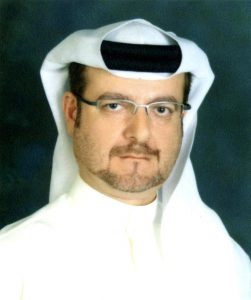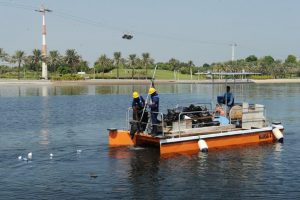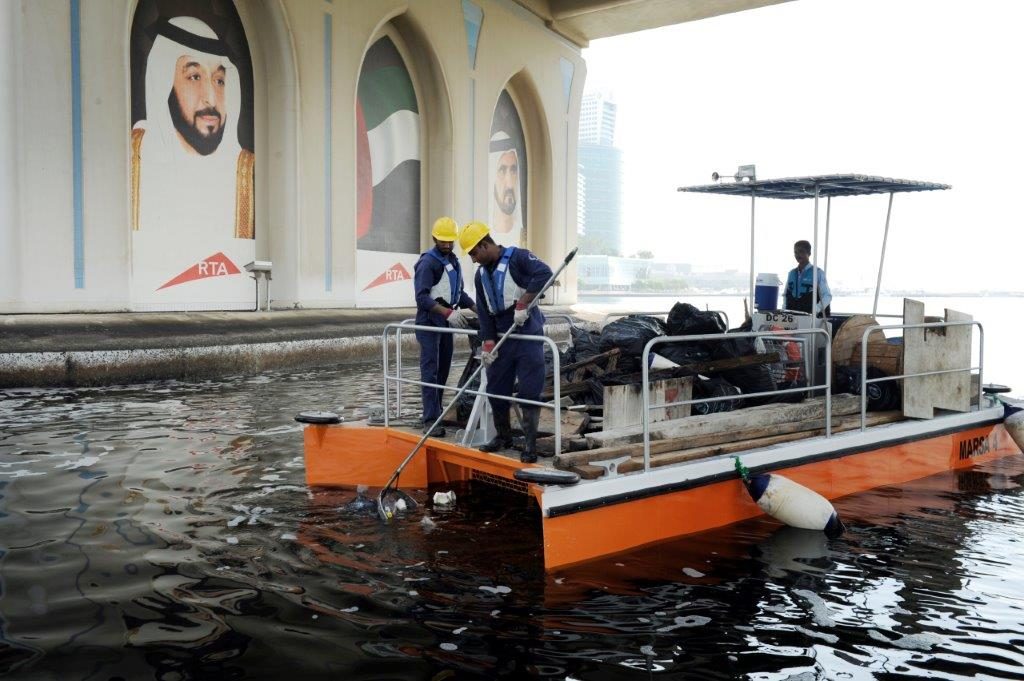In keeping with the Dubai Municipality’s keenness to preserve the cleanliness of the emirate’s waterways and creeks, the Waste Management Department has enhanced its fleet of waterway clean-up boats and implemented a range of initiatives and campaigns to keep these sites clean and sustainable, including Dubai Creek, Al Jaddaf Creek, Dubai Water Canal, and Business Bay Canal, as well as expansions and new waterways such as the waterfront overlooking the fish market and the Deira Harbor canal, as these places bear tourist, economic, and historic importance.

Eng Abdulmajeed Sifai, director of Waste Management Department at Dubai Municipality, said that the department attaches great importance to the cleanliness of water channels, and is always keen to provide the best environmental services using the best equipment and marine vehicles according to the highest technical standards to ensure the sustainability of these important sites, especially the Dubai Creek, which is the vital artery of the emirate in terms of commercial and tourism activities, other than being a historical symbol of the emirate of Dubai.
The cleaning of these sites is carried out through a specialised unit for this purpose, consisting of a supervisory and monitoring staff with a wide knowledge of the marine environment, specialising in the management of marine cleaning operations, crisis management, and maritime emergencies, as well as monitoring and issuing fines on commercial vessels and the frequenters at water canals.
The unit also comprises of technicians and operators of marine vessels with high efficiency, approved certifications, and international licenses in the field of maritime navigation. They are well acquainted with the tasks assigned to them to recover marine wastes and are capable of driving the various marine vehicles of the unit. The unit also has 50 specialist marine workers and cleaners of water canals, who have been trained and qualified specifically to perform marine cleaning tasks as well as professional dealing with all kinds of marine disasters.
As for the means and vehicles equipped for marine cleaning, the maritime fleet of the unit includes 13 marine vehicles, classified for manual and hydraulic recovery operation, equipped with the latest technologies. In addition, there are a number of marine vehicles to combat disasters and crises, and exit to the open sea when absolutely necessary.
The Waste Management Department has also provided two hydraulic belts to transport waste from the sea to landfill collection sites as well as a number of marine pollution control equipment. In addition, the Department has installed marine barriers at various sites in waterways based on the velocity of currents so that these barriers help to collect waste and reduce the spreading of waste.
As for the responsibility of water purification of canals and creeks and the amount of waste collected and the procedures, he added that the Waste Management Department harnesses all its capabilities to carry out daily and continuous marine hygiene operations throughout the year to preserve the marine environment in Dubai, which has a total cleaning distance of approximately 32km. All floating wastes and obstacles to navigation and trade are removed.
Sifai commented: “The amount of waste collected in 2017 amounted to about 1,070 tonnes, distributed in the form of wood, plastic bags, food wastes, algae, seaweed, shipwrecks, oil residues, and waste from the projects executed on the banks of the waterways, in addition to the waste resulting from the immediate response to emergencies and marine disasters such as death of fish, ship and cargo fires, and debris from ship collision or drowning. In the Waste Management Department we adopt a policy supportive of the environmental strategic direction of the Municipality.”
 Since 2010, the Waterways Cleaning Unit of the Waste Management Department has implemented a number of initiatives and campaigns, such as cleaning the bottoms of waterways and removing the abandoned ships. These campaigns resulted in the recovery of about 30 tonnes of benthic waste and the lifting and transfer of 63 neglected and sunken ships, which were a navigational danger to water channels such as the risk of collision. They also distorted the general appearance of the canals and occupied the marine docks in addition to polluting the marine environment. About 80% of these vessels have been transferred from the waters of the creek. Various governmental and private departments were coordinated with these campaigns, which also attracted volunteers from divers to the join with the campaign activities.
Since 2010, the Waterways Cleaning Unit of the Waste Management Department has implemented a number of initiatives and campaigns, such as cleaning the bottoms of waterways and removing the abandoned ships. These campaigns resulted in the recovery of about 30 tonnes of benthic waste and the lifting and transfer of 63 neglected and sunken ships, which were a navigational danger to water channels such as the risk of collision. They also distorted the general appearance of the canals and occupied the marine docks in addition to polluting the marine environment. About 80% of these vessels have been transferred from the waters of the creek. Various governmental and private departments were coordinated with these campaigns, which also attracted volunteers from divers to the join with the campaign activities.
Sifai mentioned that the future plan for the development of cleaning of water channels will include the study of a number of modern techniques and equipment used for water purification of the channels, which rely on artificial intelligence, reduce human intervention, and attract the latest and the most advanced mechanisms in order to improve performance and efficiency of marine hygiene operations, such as the introduction of a new mechanism called, WasteShark.
Sifai explained: “It is a remote-controlled, autonomous vehicle with dynamic sensors and a smart camera that tracks floating debris and removes them. It would improve the quality of work and contribute to the rationalisation of expenditures. It is also environmentally friendly, as it is electrically operated and does not release any emissions of carbon dioxide.”
He stressed the need for tourists, floating restaurant owners, commercial boat operators, and tour operators to adhere to local rules and regulations to maintain cleanliness of these areas as they are full of tourist and business activities that attract tourists and visitors throughout the year. Sifai also urged to ensure that they are placed in the designated areas provided by the municipality, which avoids fines based on the provisions of Local Order No. 11 of 2003 on Public Health and Community Safety in the emirate of Dubai, in order to reduce the effects of the negative and erroneous practices on the marine environment.

